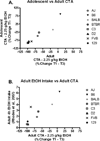Genotype modulates age-related alterations in sensitivity to the aversive effects of ethanol: an eight inbred strain analysis of conditioned taste aversion
- PMID: 23171343
- PMCID: PMC3553292
- DOI: 10.1111/gbb.12004
Genotype modulates age-related alterations in sensitivity to the aversive effects of ethanol: an eight inbred strain analysis of conditioned taste aversion
Abstract
Adolescent individuals display altered behavioral sensitivity to ethanol, which may contribute to the increased ethanol consumption seen in this age-group. However, genetics also exert considerable influence on both ethanol intake and sensitivity. Currently there is little research assessing the combined influence of developmental and genetic alcohol sensitivities. Sensitivity to the aversive effects of ethanol using a conditioned taste aversion (CTA) procedure was measured during both adolescence (P30) and adulthood (P75) in eight inbred mouse strains (C57BL/6J, DBA/2J, 129S1/SvImJ, A/J, BALB/cByJ, BTBR T(+) tf/J, C3H/HeJ and FVB/NJ). Adolescent and adult mice were water deprived, and subsequently provided with access to 0.9% (v/v) NaCl solution for 1 h. Immediately following access mice were administered ethanol (0, 1.5, 2.25 and 3 g/kg, ip). This procedure was repeated in 72 h intervals for a total of five CTA trials. Sensitivity to the aversive effects of ethanol was highly dependent upon both strain and age. Within an inbred strain, adolescent animals were consistently less sensitive to the aversive effects of ethanol than their adult counterparts. However, the dose of ethanol required to produce an aversion response differed as a function of both age and strain.
© 2012 Blackwell Publishing Ltd and International Behavioural and Neural Genetics Society.
Conflict of interest statement
The authors have no conflicts of interest to declare.
Figures



References
-
- Badia-Elder NE, Stewart RB, Powrozek TA, Woods JE, II, Murphy JM, Lumeng L, Li T-K. Ethanol- induced conditioned taste aversion in high alcohol drinking (HAD) and low alcohol drinking (LAD) rats. Alcohol Clin Exp Res. 1999;23:104A. (Abstract). - PubMed
-
- Broadbent J, Muccino KJ, Cunningham CL. Ethanol-induced conditioned taste aversion in 15 inbred mouse strains. Behav Neurosci. 2002;116:138–148. - PubMed
-
- Brunetti G, Carai MAM, Lobina C, Melis S, Serra S, Vacca G, et al. Differences in ethanol-induced conditioned taste aversion in Sardinian alcohol-preferring and Sardinian alcohol-nonpreferring rats. Alcohol. 2002;26(3):167–172. - PubMed
-
- Chester JA, Blose AM, Froehlich JC. Further evidence of an inverse-genetic relationship between innate differences in alcohol preference and alcohol withdrawal magnitude in multiple selectively bred rat lines. Alcohol Clin Exp Res. 2003;27(3):377–387. - PubMed
Publication types
MeSH terms
Substances
Grants and funding
LinkOut - more resources
Full Text Sources
Medical
Molecular Biology Databases
Research Materials
Miscellaneous

